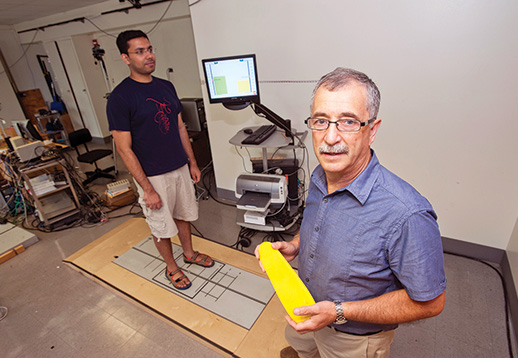Helping stroke patients keep their balance

Physical therapy professor Alexander Aruin‘s shoe insole “is very simple and inexpensive.”
Photo: Roberta Dupuis-Devlin
A stroke can weaken one side of the body, raising the dangerous possibility of unstable walking and debilitating falls.
Physical therapy helps patients learn to shift their body weight slightly to the weaker, stroke-affected side to regain balance, but for some patients, the weakness returns after their therapy ends.
Physical therapy professor Alexander Aruin has developed an inexpensive, simple way to deal with the problem, training the brain to rebalance body weight using a simple shoe insole he calls a “compelled body weight shift.”
“The outcome looks promising,” Aruin said. “The technique is very simple and inexpensive.”
The insole, which measures less than half an inch thick, slightly lifts and tilts the body toward the stroke-affected side, restoring balance without the patient even thinking about it.
Aruin, with colleagues at UIC and Marianjoy Rehabilitation Hospital in Wheaton, studied two patient groups: one group at UIC who recently had a stroke, and one at Marianjoy who had a stroke over a year ago.
“We tried a purely biomechanical approach,” Aruin said.
“We mechanically lifted the healthy side so the patient cannot resist. The mechanics force body weight to where it is distributed almost 50/50. When patients ambulate in such a condition, they learn how to bear weight equally through both extremities.
“It’s quite simple.”
Results for the two test groups, which followed slightly different protocols, were measured against control groups not using the therapeutic shoe insole. All the patients received standard post-stroke physical therapy.
After the testing period ended, patients stopped using the insole. About three months later they were tested again to see if they retained the ability to keep their balance.
Aruin and his colleagues found that physical therapy helped both the insole-user and control groups, but the insole group got an added boost.
“They showed more symmetrical body weight distribution and bore more weight on their affected side, and their gait velocity improved,” he said.
Aruin hopes other physical therapists use the simple devices on stroke patients to see if they, too, will benefit. His associates are considering ways to use the insole to improve posture in post-stroke patients.
Results are published in two journals: ISRN Rehabilitation and Topics in Stroke Rehabilitation.
The research was supported by a grant from the National Institutes of Health.
Co-authors of the ISRN Rehabilitation article include Sambit Mohapatra, Aileen Eviota, Keir Ringquist and Sri Ranjini Muthukrishnan of UIC.
